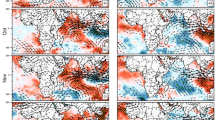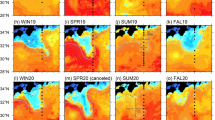We analyze the space-and-time variability of the meridional heat transport in the North Atlantic. The contribution of various mechanisms to the integral meridional heat transport (MHT) is estimated. The key role played by the drift transport of the Tropical Atlantic in the formation of the meridional oceanic heat transport is confirmed. On the basis of the general analysis of estimations obtained by various authors according to the data accumulated for 1870–2008 and the results of numerical analyses based on the data of NCEP/NCAR reanalysis, we show that the long-term average meridional drift heat (mass) transport attains its maximum values equal to (1.6 ± 0.1) PW [(17.4 ± 1.5) Sv] in the vicinity of 12.5°N in the Tropical Atlantic. The contribution of the heat transport caused by the horizontal Sverdrup circulation to the integral meridional heat transport is maximum in the vicinity of 30° N. On the average, it is equal to ∼ 40%. In the Subtropical Atlantic, the meridional heat transport varies with a period of ∼ 50–70 yr. The minimum value of the integral meridional heat transport was attained in the mid-1960s and its maximum value was at attained at the beginning of the 1990s. The location of the center of Azores pressure maximum makes it possible to conclude that the intensification of the total meridional heat transport in the Subtropical Atlantic on these time scales is accompanied by the displacement of the center of the North Subtropical anticyclonic gyre in the southwest direction.
Similar content being viewed by others
References
A. B. Polonsky, Role of the Ocean in the Variations of Climate [in Russian], Naukova Dumka, Kiev (2008).
A. B. Polonsky and S. B. Krasheninnikova, “Meridional heat transport in the North Atlantic and the trends of its variations,” Morsk. Gidrofiz. Zh., No. 1, 46–52 (2007).
H. L. Bryden, H. R. Longworth, and S. A. Cunningham, “Slowing of the Atlantic meridional overturning circulation at 25°N,” Nature, 438, 655–657 (2005).
S. A. Josey, E. C. Kent, and P. K. Taylor, “Wind stress forcing of the ocean in the SOC climatology: Comparisons with the NCEP/NCAR, ECMWF, UWM/COADS, and Hellerman and Rosenstein datasets,” J. Phys. Oceanogr., 32, No. 7, 1993–2019 (2002).
D. E. Harrison, “On climatological monthly mean wind stress and wind stress curl fields over the World Ocean,” J. Climate, 2, No. 1, 57–70 (1989).
A. B. Polonsky and E. N. Voskresenskaya, “Low-frequency variability of the meridional drift heat transport in the North Atlantic,” Meteor. Gidrolog., No. 7, 89–100 (1996).
L. S. Gandin, D. L. Laitman, L. T. Matveev, and M. I. Yudin, Foundations of Dynamic Meteorology [in Russian], Gidrometeoizdat, Leningrad (1995).
G. F. Dzhiganshin, A. B. Polonsky, and S. B. Krasheninnikova, “Influence of the interannual variability of the wind field in the subtropical gyre on the Gulf-Stream discharge,” in: Systems of Monitoring of the Environment [in Russian], Marine Hydrophysical Institute, Ukrainian Academy of Sciences, Sevastopol (2006), pp. 296–299.
S. A. Baev, N. P. Bulgakov, and A. B. Polonsky, “Seasonal and interannual variability of the drift mass and heat transport in the North Atlantic (low latitudes),” Morsk. Gidrofiz. Zh., No. 6, 29–35 (1988).
S. K. Gulev, S. S. Lappo, and V. A. Tikhonov, “Interannual dynamics of the integral characteristics of thermal interaction of the North Atlantic with the atmosphere,” Izv. Akad. Nauk SSSR. Ser. FAO, 24, No. 8, 861–872 (1988).
D. Adamec, M. M. Rienecker, and J. M. Vukovich, “The time-varying characteristics of the meridional Ekman heat transport for the World Ocean,” J. Phys. Oceanogr., 23, No. 12, 2704–2716 (1993).
C. W. Boning, R. Doscher, and H.-J. Isemer, “Monthly mean wind stress and Sverdrup transports in the North Atlantic: A comparison of Hellerman–Rosenstein and Isemer–Hasse climatologies,” J. Phys. Oceanogr., 21, No. 2, 221–235 (1991).
A.F. Bunker, “Computation of surface energy flux and annual air–sea interaction cycles of the North Atlantic Ocean,” Month. Wea. Rev., 104, No. 9, 1122–1140 (1976).
T. K. Chereskin and D. Roemmich, “A comparison of measured and wind-derived Ekman transport at 11° N in the Atlantic Ocean,” J. Phys. Oceanogr., 21, No. 6, 869–878 (1991).
E. R. Fillenbaum, T. N. Lee, W. E. Johns, and R. J. Zantopp, “Meridional heat transport variability at 26.5°N in the North Atlantic,” J. Phys. Oceanogr., 27, No. 1, 153–174 (1997).
M. M. Hall and H. L. Bryden, “Direct estimates and mechanisms of ocean heat transport,” Deep-Sea Res., 29, No. 3A, 339–359 (1982).
S. Hellerman, “An updated estimate of the wind stress on the World Ocean,” Month. Wea. Rev., 95, No. 9, 607–626 (1967).
S. Hellerman and M. Rosenstein, “Normal monthly wind stress over the World Ocean with error estimates,” J. Phys. Oceanogr., 13, No. 4, 1093–1104 (1983).
E. B. Kraus and S. Levitus, “Annual heat flux variations across the tropic circles,” J. Phys. Oceanogr., 16, No. 8, 1479–1487 (1986).
A. Leetmaa and A. F. Bunker, “Updated charts of the mean annual wind stress convergences in the Ekman layers and Sverdrup transport in the North Atlantic,” J. Mar. Res., 36, No. 3, 311–322 (1978).
S. Levitus, “Meridional Ekman heat fluxes for the World Ocean and individual ocean basins,” J. Phys. Oceanogr., 17, No. 9, 1484–1492 (1987).
A. M. Macdonald and C. Wunsch, “An estimate of global ocean circulation and heat fluxes,” Nature, 382, 436–439 (1996).
R. L. Molinari, E. Johns, and J. F. Festa, “The annual cycle of meridional heat flux in the Atlantic Ocean at 26.5°N,” J. Phys. Oceanogr., 20, No. 3, 476–482 (1990).
T. A. Rago and T. H. Rossby, “Heat transport into the North Atlantic Ocean of 32°N latitude,” J. Phys. Oceanogr., 17, No. 7, 854–871 (1987).
D. Roemmich, “The balance of geostrophic and Ekman transports in the tropical Atlantic Ocean,” J. Phys. Oceanogr., 13, No. 8, 1534–1539 (1983).
D. Roemmich and C. Wunsch, “Two transatlantic sections: meridional circulation and heat flux in the subtropical North Atlantic Ocean,” Deep-Sea Res., 32, No. 6, 619–664 (1985).
O. T. Sato and P. S. Polito, “Comparison of the global meridional Ekman heat flux estimated from four wind sources,” J. Phys. Oceanogr., 35, No. 1, 94–108 (2005).
O. T. Sato and T. H. Rossby, “Seasonal and low-frequency variability of the meridional heat flux at 36° N in the North Atlantic,” J. Phys. Oceanogr., 30, No. 3, 606–621 (2000).
L. D. Talley, “Shallow, intermediate, and deep overturning components of the global heat budget,” J. Phys. Oceanogr., 33, No. 3, 530–560 (2003).
K. E. Trenberth and J. M. Caron, “Estimates of meridional atmosphere and ocean heat transports,” J. Clim., 14, No. 16, 3433–3443 (2001).
K. E. Trenberth, W. G. Large and J. G. Olson, “The mean annual cycle in global ocean wind stress,” J. Phys. Oceanogr., 20, No. 11, 1742–1760 (1990).
T. L. Townsend, H. E. Hurlburt, and P. J. Hogan, “Modeled Sverdrup flow in the North Atlantic from 11 different wind stress climatologies,” Dyn. Atmosph. Ocean., 32, Nos. 3–4, 373–417 (2000).
M. I. Budyko, Atlas of the Heat Balance of Earth, Glob. Geofiz. Observ., Moscow (1963).
T. H. V. Haar and A. H. Oort, “New estimate of annual poleward energy transport by Northern hemisphere oceans,” J. Phys. Oceanogr., 3, No. 2, 169–172 (1973).
P. T. Lamb and A. F. Bunker, “The annual march of heat budget of the North and tropical Atlantic Ocean,” J. Phys. Oceanogr., 12, No. 12, 1388–1410 (1982).
A. H. Oort and T. H. V. Haar, “On the observed annual cycle in the ocean–atmosphere heat balance over the Northern hemisphere,” J. Phys. Oceanogr., 6, No. 6, 781–800 (1976).
N. A. Timofeev and A. V. Yurovskii, Radiation, Heat, and Water Balance Modes of the Oceans. Climate and Variability [in Russian], ÉKOSI-Gidrofizika, Sevastopol (2004).
S. Hastenrath, “Heat budget of ocean,” J. Phys. Oceanogr., 10, No. 2, 159–170 (1980).
S. Hastenrath, “On meridional heat transport in the World Ocean,” J. Phys. Oceanogr., 12, No. 8, 922–927 (1982).
J. Hsuing, “Estimates of global oceanic meridional heat transport,” J. Phys. Oceanogr., 15, No. 11, 1405–1413 (1985).
A. A. Dunets, V. I. Klimok, and A. B. Polonsky, “Mass balance and heat transport in the Equatorial Atlantic,” Morsk. Gidrofiz. Zh., No. 1, 22–29 (1991).
W. Krauss, “The North Atlantic Current,” J. Geophys. Res., 91, No. C4, 5061–5074 (1986).
A. Köhl and D. Stammer, “Variability of the meridional overturning in the North Atlantic from the 50-year GECCO state estimation,” J. Phys. Oceanogr., 38, No. 9, 1913–1930 (2008).
A. S. Sarkisyan, “Four decades since the discovery of the role played by the joint effect of baroclinicity and bottom topography in modeling the climatic characteristics of the ocean,” Izv. Akad. Nauk SSSR. Ser. FAO, 42, No. 5, 582–603 (2006).
A. B. Polonsky, “Is the process of warming of intermediate waters of the subtropical gyre in the North Atlantic indeed observed?” Morsk. Gidrofiz. Zh., No. 6, 76–81 (2000).
A. B. Polonsky and S. B. Krasheninnikova, “Low-frequency variations of the drift and integral meridional heat transports in the North Atlantic,” Meteor., Klimat. Gidrol., Issue 50, Pt. 2, 196–201 (2008).
A. A. Sizov, “On the large-scale variability of the circulation and thermal state of the atmosphere and the ocean in the North Atlantic,” Morsk. Gidrofiz. Zh., No. 5, 22–26 (1991).
Author information
Authors and Affiliations
Corresponding author
Additional information
Translated from Morskoi Gidrofizicheskii Zhurnal, No. 6, pp. 24–41, November–December, 2010.
Rights and permissions
About this article
Cite this article
Polonsky, A.B., Krasheninnikova, S.B. Space-and-time variability of the meridional heat transport in the north atlantic. Phys Oceanogr 20, 419–434 (2011). https://doi.org/10.1007/s11110-011-9096-4
Received:
Revised:
Published:
Issue Date:
DOI: https://doi.org/10.1007/s11110-011-9096-4




